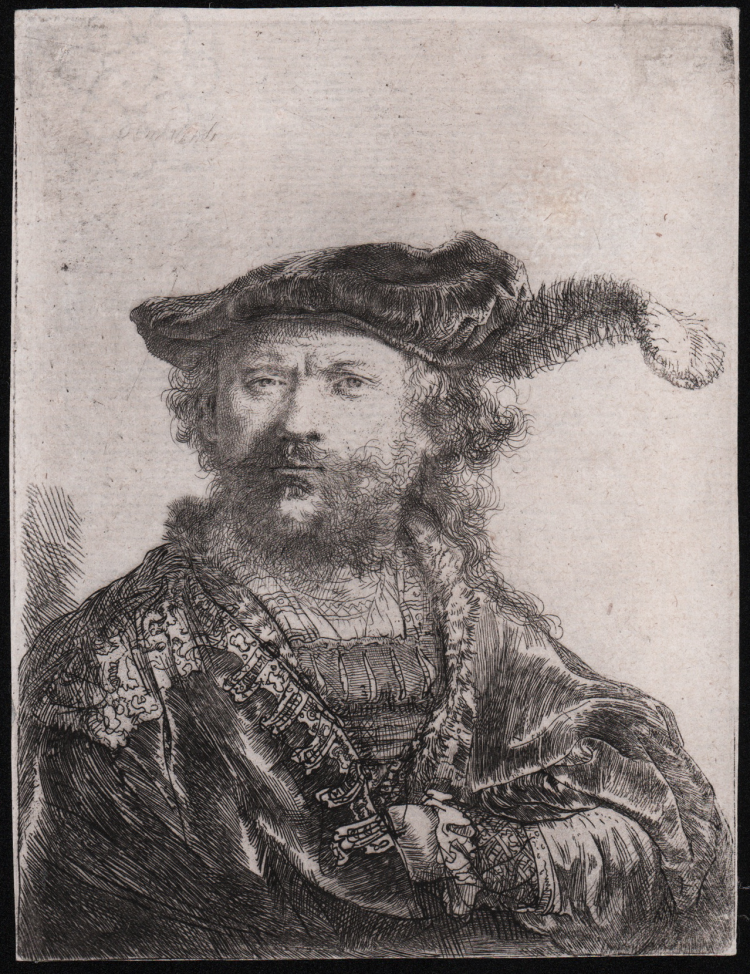





| Reference: | S45075 |
| Author | Harmensz van Rijn detto REMBRANDT |
| Year: | 1638 |
| Measures: | 105 x 139 mm |




| Reference: | S45075 |
| Author | Harmensz van Rijn detto REMBRANDT |
| Year: | 1638 |
| Measures: | 105 x 139 mm |
Etching, signed and dated Rembrandt f 1638 in the upper left of the image.
A fine impression, printed on contemporary laid paper with “grapes” watermark [Ash & Fletcher pp. 121-124, type E (medium sized grapes with thick stem diverging toward the grapes), about 1654], trimmed to the platemark or with thin margins, perfect condition.
Rembrandt painted and drew a great many records of his own features, now highly prized for their penetrating introspection. His flamboyant self-image here contrasts strongly with the more low-key versions created a decade later.
“In 1638, Rembrandt again etched himself wearing a feathered velvet beret, but replaced his casual shirt and jacket with more clearly anachronistic dress. His wild, wiry hair and frowning gaze convey an electric creative energy. More than on author has associated this self-portrait with an engraving of the sixteen-century painter Jan Gossaert. This connection reveals Rembrandt’s consciousness of his participation in a historical continuum of renowned artists and in the community of art lovers who cultivated an appreciation for their works” (cf. S. Dickey, Rembrandt Portraits in Print, p. 28).
Contemporary proof of this famous self-portrait. Collection mark on verso, not readable.
References
Hind 156; Bartsch 20; The New Hollstein (Rembrandt).31.170, II/IV; Biörklund, 38-B; White – Boon, B20; Ash & Fletcher, Watermark in the Rembrandt prints, pp. 121-124.
Harmensz van Rijn detto REMBRANDT (Leida 1606 - Amsterdam 1669)
|
Born in Leiden, Holland in 1606, Rembrandt studied with Jacob Isaacsz van Swanenburgh (1571-1638) and Pieter Lastman (1583-1633). By 1626 he was an independent painter, working in Leiden alongside Jan Lievens (1607-74), another pupil of Lastman.
In 1631 Rembrandt moved to Amsterdam where he painted portraits of wealthy merchants. Three years later, he married his first wife, Saskia, and by the end of the 1630s he had moved into a substantial house (now the Rembrandt House Museum). In 1642, the year Rembrandt completed The Nightwatch (Rijksmuseum, Amsterdam), Saskia died.
By 1649, Hendrikje Stoffels had become his housekeeper and partner. Both Saskia and Hendrikje Stoffels posed for many paintings and sketches, often appearing as Susannah, Diana, Flora, Artemisa and other classical or Biblical figures. Rembrandt, however, was plagued by financial troubles and in 1656 his assets were made over to the courts, and many were sold. With his wife and son in financial control, Rembrandt continued to paint. Hendrikje died in 1663, his son Titus in 1668 and Rembrandt himself in 1669.
In his drawings, etchings and paintings, Rembrandt treated every subject: histories, landscapes, portraits, self-portraits, everyday scenes or sketches from nature. Rembrandt's biographer, Cornelis de Bie, praised his paintings, 'which enlighten every mind', and his etchings which are 'the very soul of life that lives therein'.
|
Harmensz van Rijn detto REMBRANDT (Leida 1606 - Amsterdam 1669)
|
Born in Leiden, Holland in 1606, Rembrandt studied with Jacob Isaacsz van Swanenburgh (1571-1638) and Pieter Lastman (1583-1633). By 1626 he was an independent painter, working in Leiden alongside Jan Lievens (1607-74), another pupil of Lastman.
In 1631 Rembrandt moved to Amsterdam where he painted portraits of wealthy merchants. Three years later, he married his first wife, Saskia, and by the end of the 1630s he had moved into a substantial house (now the Rembrandt House Museum). In 1642, the year Rembrandt completed The Nightwatch (Rijksmuseum, Amsterdam), Saskia died.
By 1649, Hendrikje Stoffels had become his housekeeper and partner. Both Saskia and Hendrikje Stoffels posed for many paintings and sketches, often appearing as Susannah, Diana, Flora, Artemisa and other classical or Biblical figures. Rembrandt, however, was plagued by financial troubles and in 1656 his assets were made over to the courts, and many were sold. With his wife and son in financial control, Rembrandt continued to paint. Hendrikje died in 1663, his son Titus in 1668 and Rembrandt himself in 1669.
In his drawings, etchings and paintings, Rembrandt treated every subject: histories, landscapes, portraits, self-portraits, everyday scenes or sketches from nature. Rembrandt's biographer, Cornelis de Bie, praised his paintings, 'which enlighten every mind', and his etchings which are 'the very soul of life that lives therein'.
|